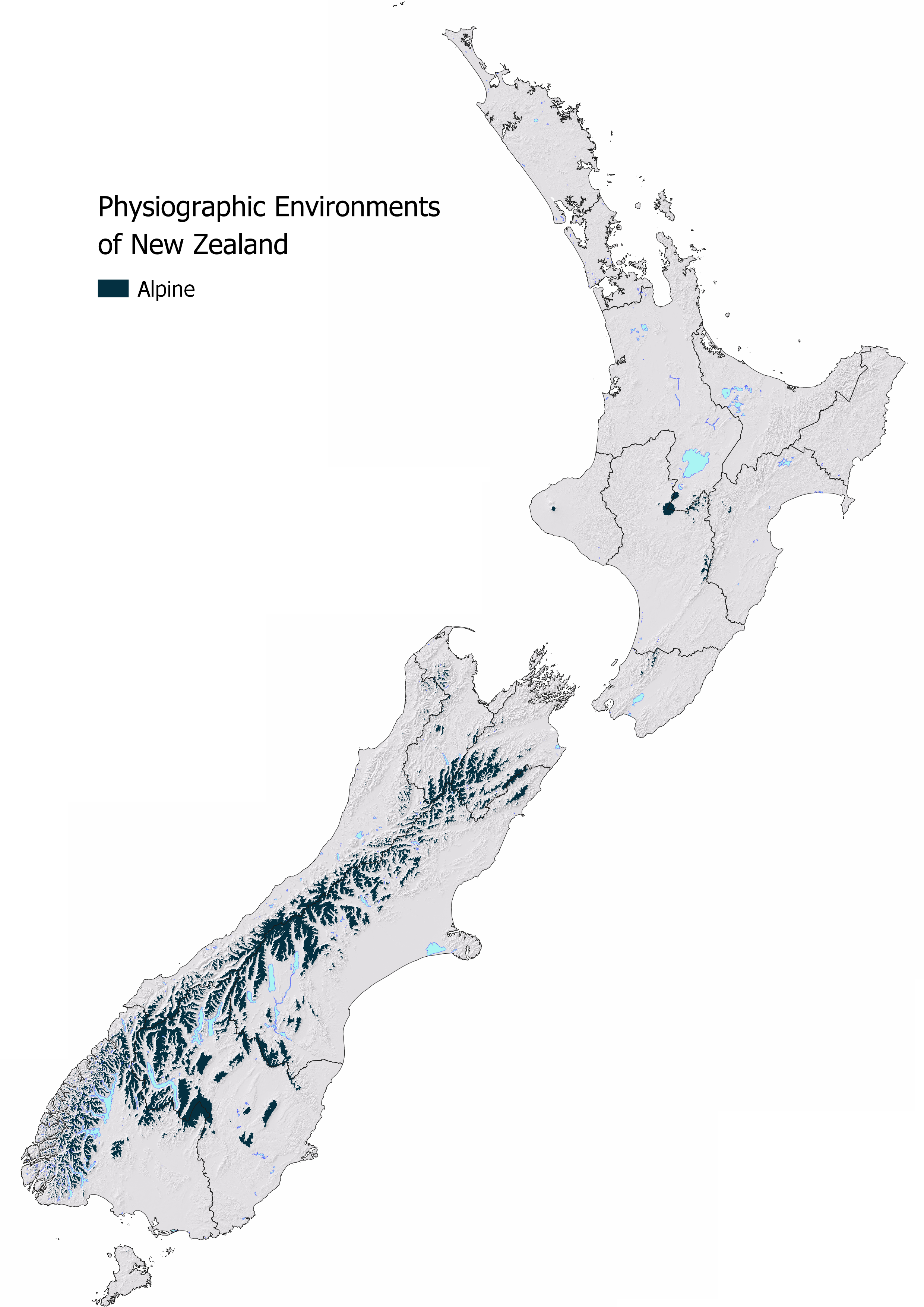Alpine
Occurrence
The Alpine Environment is found at high altitude (> 800 m elevation) throughout the Southern Alps of New Zealand, and the high peaks of the North Island. It is located above the treeline, where soils are typically poorly developed, shallow, and low in organic carbon. Aquifers are unlikely in this environment.
Nationally 8.22% or 2,165,178 ha of New Zealand is classified as Alpine Environment. Canterbury, Otago, and Southland have the largest areal extent. Otago has the highest proportion of the region classified as Alpine Environment.
| Region | Area (ha) | Regional (%) | National (%) |
|---|---|---|---|
| Canterbury | 682,093 | 15.38 | 2.59 |
| Otago | 531,977 | 17.09 | 2.02 |
| Southland | 413,493 | 13.29 | 1.57 |
| West Coast | 279,206 | 12.07 | 1.06 |
| Marlborough | 137,431 | 13.15 | 0.52 |
| Tasman | 70,596 | 7.35 | 0.27 |
| Manawatu | 28,571 | 1.29 | 0.11 |
| Waikato | 12,151 | 0.51 | 0.05 |
| Wellington | 4,085 | 0.51 | 0.02 |
| Hawkes Bay | 3,916 | 0.28 | 0.01 |
| Taranaki | 1,640 | 0.23 | 0.01 |

Water Source and Flow Pathway
The majority of precipitation accumulates as snow over the winter months and seasonal melt water either runs off across bare rock or infiltrates through thin shallow soils and moves laterally towards low lying valleys where it forms rivers. This environment has a high precipitation volume relative to other environments, providing a significant volume of pristine, strongly oxidising water to hill and lowland environments.
Landscape Characteristics
As water discharges relatively quickly and has little interaction with the soil or underlying geology, the resultant drainage waters are typically very dilute, and low in minerals commonly found in surface or ground water. Sediment transported from this environment is predominantly less reactive due to the low nutrient status, however the volume may be large. As this environment is largely natural state, under conservation protection, or not used for agricultural production, there is little evidence for contamination due to little if any land use pressure.
In subalpine environments, where extensive hill country farming occurs, the impact of land use is hard to detect and quantify due to large volumes of dilute alpine sourced water. While water quality is high in these relatively pristine environments, it is still important to reduce contaminant losses as much as possible to minimise the total load delivered to rivers, lakes, and estuaries. As the nutrient status of the soil increases, so too does the risk of the sediment to degrade waterways. Surface water takes and groundwater abstraction from this environment decreases the dilution potential of the water down catchment as the volume of alpine sourced water is reduced.
Sibling and Variations
There are no siblings or variants within the Alpine Environment.
| Alpine Environment | Contaminant pathway (dominant hydrological pathway) | How the landscape regulates water quality contaminants | Risk to receiving environment | ||||
|---|---|---|---|---|---|---|---|
| Dilution | Resistance to erosion | Filtration and adsorption | Attenuation: N-Reduction | Attenuation: P-Reduction | |||
| Alpine | Precipitation falls mainly as snow over the winter months and accumulates until spring. Melt water runs over the land surface and converges to form streams. Overland flow is the dominant pathway water takes to leave the land. | High | Low | Low | Low | Low | Load to surface water |
Contaminant Profile
| Alpine Environment | Nitrogen | Phosphorus | Sediment | Microbes | |||
|---|---|---|---|---|---|---|---|
| Nitrate & Nitrite | Ammoniacal | Organic (Dissolved & Particulate) | Particulate | Dissolved Reactive | Particulate | Particulate | |
| Alpine* | High | High | High | High | High | High | High |
*Alpine Environment has a low risk to water quality overall as there is no source. The nutrient content of sediment is low and sediment transported constitutes background load.
Key Actions
In the Alpine (and Subalpine Environments) keep land use pressure to a minimum. Utilise tussock grasses and other vegetation as a way of retaining sediment and other contaminants on vulnerable hill slopes, gullies, and near waterways. Use targeted approaches for applying nutrients to avoid direct discharges to water.